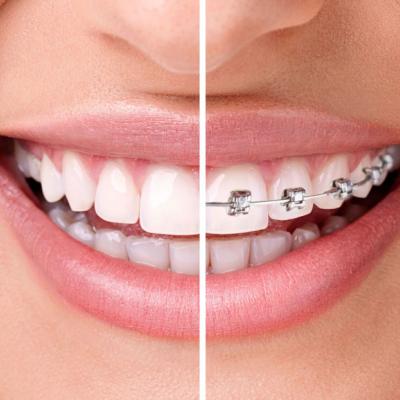Orthodontics – Effective Treatment for Children, Teens and Adults
Malocclusion ("bad bite") is not just a cosmetic issue — it can also impact oral health and overall well-being. Bite misalignment may lead to jaw joint problems, tooth wear, headaches, speech difficulties, or trouble chewing. Orthodontics focuses on diagnosing and treating such conditions using safe and modern methods.
Our clinic provides comprehensive orthodontic care for patients of all ages. We offer fixed and removable braces as well as clear aligners (such as Invisalign). Each treatment plan is individually tailored based on the patient’s age, bite condition, and desired outcome.
Appointment booking hours:
Monday - Friday 7:30am - 8pm
Saturday - 8am - 5pm
Sunday - 10am- 5pm
Our locations:
Polish Medical and Dental Clinic - Poland Medical London
377 High Road
Harrow
HA3 6EL
Tel.: 0208 903 4874
Tel./Fax: 0208 903 3455
Mobile: 077 466 231 02
Polish Medical and Dental Clinic - Poland Medical Coventry
30 Park Road
Coventry
CV1 2LD
Tel.: 024 7767 1780
Mobile: 077 126 585 38
Scope of Orthodontic Services
-
Orthodontic consultation with full diagnostics (including X-rays and models)
-
Treatment for children and adolescents using fixed or removable braces
-
Adult orthodontics – including complex cases with periodontal disease or prosthetic planning
-
Metal, aesthetic (ceramic) and self-ligating braces
-
Clear aligner therapy with Crystaline (type of Invisalign)
-
Retention after treatment – fixed or removable retainers
-
Interdisciplinary collaboration with oral surgeons, prosthodontists, speech therapists, and physiotherapists
Why Start Orthodontic Treatment?
-
Improved smile aesthetics and facial harmony
-
Easier oral hygiene – reduced risk of cavities and gum disease
-
Protection of the jaw joints from excessive strain
-
Better chewing, speech, and breathing function
-
Essential preparation for prosthetic or implant treatment
-
Enhanced self-confidence and quality of life
Orthodontic Treatment Process
Orthodontic treatment is a structured process that requires consistency and regular follow-up visits. Here’s what it usually involves:
1. Initial Consultation
We begin with a clinical exam and patient interview. Based on this, diagnostic tests are ordered (e.g. panoramic X-ray, cephalometric scan, intraoral photos, digital impressions).
2. Treatment Plan
After analyzing the diagnostics, the orthodontist prepares a personalised treatment plan. You’ll receive information about available options, treatment time, costs, and stages of therapy.
3. Fitting the Appliance
Depending on the chosen method, the patient receives a fixed brace, removable appliance, or a set of clear aligners. Instructions are provided for daily care and hygiene.
4. Follow-Up Visits
Regular check-ups are essential — typically every 4–8 weeks. The orthodontist adjusts the appliance and monitors progress, making changes as needed.
5. Treatment Completion and Retention
Once the desired result is achieved, the braces are removed. A retainer is then used (fixed or removable) to maintain the results long term. Follow-up visits help ensure the stability of the outcome.
Orthodontics London - Frequently Asked Questions
What does an orthodontist do
An orthodontist is a dentist trained to diagnose, prevent, and treat teeth and jaw irregularities. They correct existing conditions and are trained to identify problems that may develop in the future. Orthodontists work with people of all ages, from children to adults.
Misalignment, or malocclusion, is the most common reason people see an orthodontist. It's hereditary and is the result of size differences between the upper and lower jaw, or between the jaw and the teeth. Malocclusion leads to tooth overcrowding, a misshapen jaw, or irregular bite patterns.
Main focus of orthodontic treatment
Orthodontists use fixed and removable dental devices, like braces, retainers, and bands, to change the position of teeth in the mouth. They treat dental abnormalities, including:
- crooked teeth
- bite problems, like an overbite or an underbite
- crowded teeth, or teeth that are too far apart
- jaw misalignment
The goal of orthodontic care is to improve a patient's bite. Teeth that are straight and evenly spaced will align with opposing teeth in the jaw. A healthy bite ensures you can eat, chew, and speak properly. In the past, seeing an orthodontist was associated with children or teenagers who needed braces. However, orthodontists can correct dental problems at any age.
What can you achieve
• maintain healthy teeth, periodontium and temporomandibular joints
• improve the aesthetics of the face
• get straight teeth and a beautiful smile
• improve the bite
• protect against periodontal disease
• eliminate teeth overcrowding
• eliminate some speech impediments
• cure periodontitis
Orthodontic treatment can also be a step before putting in a denture or implants (by an oral surgeon).
Examination
For diagnostic purposes, orthodontist uses available tests that allow to assess the patient's bite. After a conversation with the patient, they perform an extraoral and intraoral examination, and take photographs and x-rays.
Treatment
Orthodontic treatment consists of several stages. During the first visit, the orthodontist performs a basic check-up, checks whether the teeth are healthy and free of tartar. Then they order additional examinations, X-rays and dental impressions. Based on the results of diagnostic tests, they will be able to plan the treatment and its cost. The next step is to choose and put on orthodontic braces. Braces are still the most effective method of orthodontic treatment. They differ in technology, method of attachment and duration of treatment, so it is an important decision that affects the final result. During this visit, orthodontist instructs the patient on how to use the braces, and also provides information on the recommended diet and the need to maintain oral hygiene. The next visits are to control the treatment by adjusting the braces and possible perform an X-ray.

